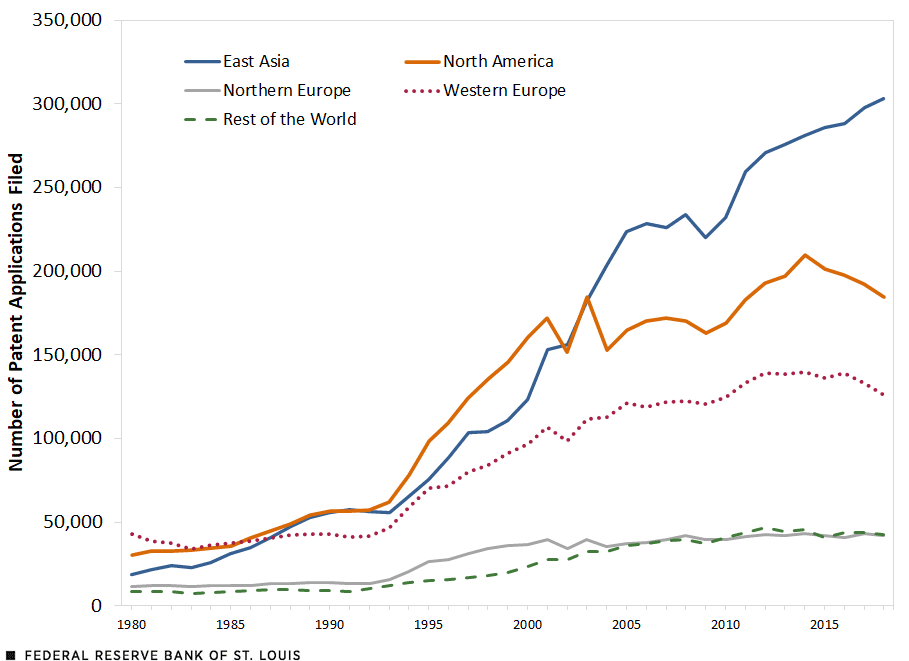East Asia Outpaces Other Regions in International Patenting
The global need for patent protection has increased substantially over the last couple of decades. Because patents are territorial (they offer protection only in the jurisdiction where they are granted), innovators typically seek patent protection in multiple countries where they are interested in doing business to prevent the theft of ideas or to keep technological competition at bay. That was the case of the United States in Asia during the decades following the formation of the World Trade Organization, as we documented in a December 2021 essay in Economic Synopses.
In this blog post, we document changes in the patterns of patenting across regions around the world. We use data on patent applications filed by 213 jurisdictions, grouped into 14 regions.
The figure below shows the evolution in the number of foreign patent applications filed by different regions of the world in foreign jurisdictions. By 2003, East Asia (mainland China, Hong Kong, Japan, Macao, Mongolia, South Korea and Taiwan) had surpassed North America (Canada, Greenland and the United States) in terms of filing patents in other jurisdictions.Patent Applications Filed Internationally by Key Regions

SOURCES: The European Patent Office’s PATSTAT database and authors’ calculations.
While the rate of patent applications filed abroad from North America slowed in the past few years, it continued to rise substantially in East Asia, widening the gap and positioning East Asia as one of the main innovation hubs seeking protection abroad. North America and East Asia were followed by Western Europe (Austria, Belgium, France, Germany, Liechtenstein, Luxembourg, Monaco, the Netherlands and Switzerland). Meanwhile, the growth rate in patent applications from northern EuropeThis region comprises the Aland Islands, the Channel Islands, Denmark, Estonia, the Faroe Islands, Finland, Iceland, Ireland, the Isle of Man, Latvia, Lithuania, Norway, the Svalbard and Jan Mayen islands, Sweden and the U.K. and from the rest of the world have been stable in recent years.
East Asia Rises as a Patent Application Destination
Exploring patenting activity in East Asia further, we found that the main innovator, according to this measure of foreign patents, was Japan, accounting for 61% of the region’s foreign patent applications from 2010 to 2019. South Korea, China and Taiwan followed, filing 18%, 12% and 7%, respectively, of patent applications abroad.
East Asia has risen not only as an innovation hub (i.e., filing patents abroad) but also as the main destination where inventors around the world seek patent protection.
Of all the patents filed abroad by applicants in North America during the 2010s, 41% went to East Asia, while just 13% stayed in the region, and 11% went to Western Europe. Those in Western Europe showed a slight preference for East Asia, with 37% of their patents filed abroad going to the region, compared with 34% filed in North America.
Even East Asian countries have a preference for their own region. Of all the patent applications filed by East Asian countries to other jurisdictions, 43% went to North America, while 36% stayed within the region, and 11% went to Western Europe.
These patterns of international patenting indicate a bias for seeking patent protection in East Asia, not only by countries outside the region but also by intraregional countries. The shift toward Asia has not always been the case. Instead, in the 1980s and early 1990s, the other most innovative regions were filing for patents with one another, while Asia was behind in both the origin and the destination of patent applications.
High-Tech Competition Builds in East Asia
What explains these new trends? There could be several reasons why East Asia has become the main destination where countries around the world seek patent protection.
First, Asia is an important destination of technology-intensive goods imports and foreign direct investment from North America and Western Europe. Hence, inventors in these developed regions may want to protect their exported technologies from theft and misappropriation by competitors in Asian countries.
Second, Asian economies are becoming innovation powerhouses, increasing competition for high-tech goods within the region. For instance, the Japanese and South Korean technology sectors have grown substantially, whereas China and Taiwan have been dominating the manufacturing of semiconductors. This regionally strong growth may have led to a “race to patent,” as each country attempts to become the dominant innovative force in that region and ward off competition.
In summary, foreign patenting has been increasing substantially in recent decades. While the U.S. and Western Europe have historically been seen as innovation powerhouses, East Asia has quickly established itself as both the main origin of innovations and the main destination for patent protection.
Note
- This region comprises the Aland Islands, the Channel Islands, Denmark, Estonia, the Faroe Islands, Finland, Iceland, Ireland, the Isle of Man, Latvia, Lithuania, Norway, the Svalbard and Jan Mayen islands, Sweden and the U.K.
Citation
Ana Maria Santacreu and Jesse LaBelle, ldquoEast Asia Outpaces Other Regions in International Patenting,rdquo St. Louis Fed On the Economy, Oct. 3, 2022.
This blog offers commentary, analysis and data from our economists and experts. Views expressed are not necessarily those of the St. Louis Fed or Federal Reserve System.
Email Us
All other blog-related questions



